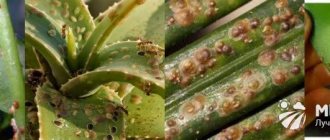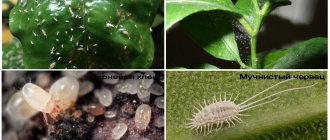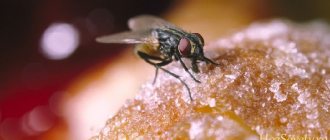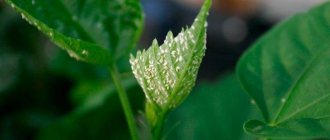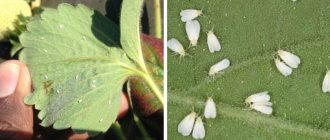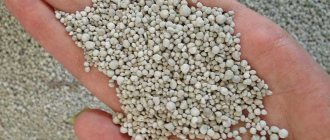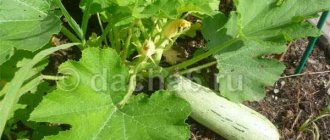This small insect came to the European continent from the countries of South America with a warm and humid climate. Therefore, its main habitat becomes enclosed spaces with high humidity. Since whiteflies can cause significant harm to plants in a short time, many methods have been developed to combat the pest in greenhouses.
Tiny insect causes a lot of damage in agriculture
When choosing an effective method of how to get rid of whiteflies, you should understand that it should affect not only the mature individual, but also the insect larvae.
What does a whitefly look like?
The body of an adult is yellowish in color and covered with a white coating. Its length is about 2 mm with a width of 0.4 to 0.7 mm. On the head are clearly visible long antennae and a pair of dark eyes.
Two pairs of opaque white wings, like the body, are covered with pollen. Sometimes they may have dark, blurry spots of varying sizes. The insect has 3 pairs of legs, divided into segments, that are clearly visible.
Life cycle of a pest
In temperate climates, the whitefly can overwinter both near the surface of the earth in a layer of plant debris and under the bark of trees. Therefore, when deciding how to get rid of whitefly larvae in the ground, you should dig up the soil in order to freeze it, promptly burn fallen leaves and grass, and also turn over compost heaps.
Life cycle of a pest
Adult females begin to lay eggs in the second half of spring or early summer, when stable air temperatures range from 20 to 30°C.
Insects attach eggs to the lower surface of leaves in small chaotic groups or in the form of rings of 50-300 pieces. In appearance, they resemble clusters of transparent scales.
After 9 days, a larva emerges from the egg and goes through 4 stages of development:
- At the first stage, the length of the larva does not exceed 0.3 mm. The body has a flat oval shape, with antennae and legs visible on it, allowing the larva to move in search of food during the first 15 hours after emerging from the egg. Having found a suitable part of the plant, it sticks to it, stops moving and begins to actively feed. Together with the juice, the larva receives the amino acids necessary for its further development. This phase lasts about two weeks and ends with the molting process.
- The second stage is characterized by the appearance of not yet developed antennae and legs.
- At the third stage, the nymph's body becomes greenish and covered with a wax-like coating. Eyes appear on the front of the body.
- At the fourth stage, the size of the larva reaches 0.75 mm. The body ceases to be flat and becomes noticeably rounded. Over the course of 13-15 days, anatomical formations characteristic of adult individuals appear on it.
After emerging from the pupa, the imago is ready to reproduce. Therefore, fertilization, egg laying and death of insects occur within 14-30 days.
There is no clear answer to the question whether a whitefly that overwinters in a greenhouse can produce offspring at this time or whether this requires it to overwinter in a dormant state. The development process of an insect very much depends on the temperature of the surrounding air and the presence of a nutrient substrate.
In heated greenhouses with temperatures above 25°C, reproduction occurs throughout the year. But whether a whitefly can survive in a greenhouse where there is no heating, or whether it dies in winter, depends on the quality of soil cultivation.
Signs of plant infection
You may not immediately suspect that a whitefly has appeared in the greenhouse. This is due to the fact that the eggs, which look like translucent scales, are located on the back surface of the leaves and do not manifest themselves in any way. Only after the larvae emerge from them can you notice a change in the condition of the plants, indicating that they have a whitefly infestation, and think about how to deal with it in a greenhouse.
It is quite difficult to notice the eggs by chance, since they are on the back of the leaves
The main signs indicating the presence of a pest are:
- the presence on the leaves of plants of a sticky coating secreted by the larvae during the period of active sucking of juices;
- the appearance of yellow spots on the leaves with blurred edges;
- deformation of leaves followed by curling, yellowing and dying;
- the presence of spores of a parasitic fungus in the form of a sooty coating on the leaves.
What do you need to know about the pest?
The pest belongs to the class of Lepidoptera, but its body structure is more reminiscent of an aphid. The average length of one individual is 2-3 mm . Visually, whiteflies are small white butterflies that sit on a plant or circle above it. The pest has 4 wings covered with a white coating. Parasites appear in heat and high humidity (from +30 and above). There are more than 20 species of pests in total.
The most common are:
- tobacco, cotton and citrus (homeland - South Asia);
- greenhouse (origin from South America);
- cabbage and strawberry (habitat - middle latitude of Russia).
A characteristic sign of whitefly infection is a white coating on the top of the leaf that glitters in the light. This plaque is a waste product of the pest. It contains pathogens of many viral diseases (jaundice, chlorosis, leaf curl). Later, whitefly defecation may develop into sooty fungus.
Causes of whitefly
When planting plants in a greenhouse, you need to know what causes whiteflies to appear and what factors contribute to this. The main ones include:
- temperature range from 20 to 30°C;
- increased humidity coefficient;
- crowding of plants;
- poor or no ventilation.
If the greenhouse is heated during the cold season, then the whitefly overwinters in it, maintaining its ability to reproduce. At the same time, there are several answers to the question of where whiteflies come from in a greenhouse:
- migrates independently from open areas;
- introduced with infected plants;
- gets in with humus or compost.
Knowing the conditions in which the whitefly prefers to develop, you can decide how to get rid of it in the country.
Main prerequisites for infection
Whiteflies almost always attack plants that are grown under:
- the highest temperature;
- high humidity;
- excessive density of plants;
- stale air.
Often the pest settles in greenhouses, where all the reasons listed above are located. Whiteflies also feel comfortable in mini-greenhouses that apartment owners set up on windowsills for the purpose of feeding seedlings.
Therefore, at high humidity temperatures, you need to pay attention to the natural movement and flow of fresh air. In addition, the source of infection can be purchased soil or already infected plants. The most common and obvious method for a pest to enter an apartment is an open window or vent.
How to remove whiteflies from a greenhouse
When choosing a way to defeat whiteflies in a greenhouse, it is worth taking into account the type of plants planted in it, the degree of infestation and technical conditions that allow for various types of treatments.
In greenhouse conditions, the pest feels great, so it is imperative to fight it
Any method can be used to process ornamental plants, but if we are talking about fruit crops, then preference should be given to mechanical and biological methods.
For example, when deciding how to deal with whiteflies on tomatoes and cucumbers during the flowering period, you can use traditional methods of spraying with decoctions of certain plants or washing the foliage with laundry soap. When there are fruits on cucumbers and tomatoes, traps and mechanical collection of adult moths and their larvae are suitable.
Treatment of the greenhouse in the fall immediately after harvesting helps to minimize the possibility of insect spread:
- Before carrying out such activities, the greenhouse space should be cleared of old plants infected with whitefly. They must be burned and not buried in the ground or stored in an open area.
- Next, before digging up the ground, it should be treated in the fall against whiteflies with a mixture of equal parts of copper sulfate and lime. Experts recommend dissolving 400 g of the mixture in 10 liters of water. This procedure can be carried out no more than once every five years. An alternative is a solution of potassium permanganate, diluted to a faint pink color.
- To get rid of whiteflies in a greenhouse, it is necessary to remove the transparent covering of the structure made of polycarbonate or other material for the entire cold period. If this is not technically possible, soil freezing should be ensured in any other possible way.
In this case, gardeners often have a question about whether it is necessary to wash the greenhouse after it has been infested with whitefly, if it is still exposed to low temperatures. The fact is that this insect is a carrier of many viral and fungal plant diseases, which retain their viability even in the cold season. Therefore, it is definitely worth washing the frame and greenhouses from whiteflies and other parasites with a bleach solution before finishing autumn agricultural work.
Mechanical method
The safest methods of controlling these pests are mechanical methods:
- First, you must try to remove all the larvae and adults by hand or wash them off with water and laundry soap dissolved in it. The disadvantages of this method are the labor intensity and duration of the process. It is logical that it will not be possible to destroy all pests 100%, but this will help preserve the plants and harvest the harvest.
- The most effective and well-proven remedy against this pest in greenhouses are glue traps. You can buy finished products or make them yourself. For this purpose, it is worth using cardboard or pieces of plywood painted orange-yellow, which attracts insects. Next, you should bring a mixture of equal parts of castor oil, rosin, caramel and petroleum jelly to a homogeneous mass in a water bath. Let it cool slightly, smear the prepared forms with it and place them next to the infected plants. Adults very quickly fly to the bait, stick to it and die, but the eggs remain intact.
This method is most suitable for the spring period, when there is a mass emergence of females after wintering, as well as for the time of fruit ripening and harvesting.
Chemicals
If mechanical methods are ineffective, it is worth resorting to synthetic control agents that help destroy pests at all stages of development. You should carefully study the effect of water-soluble tablets, powders, liquids and solutions that allow you to use chemicals to fight these insects.
The list of the most popular drugs used to poison whiteflies in a greenhouse includes:
- “Aktara”, which affects the digestive system of adults and larvae in such a way that they stop sucking juice from plants, continuing to maintain their viability for a certain period.
- “Aktellik”, spraying with which leads to the death of pests within an hour.
- "Oberon" kills whitefly nymphs and sterilizes mature individuals.
- "Karbofos" almost instantly kills insects and their larvae only with direct contact during spraying.
A regular fumigator will also help in the fight against whiteflies. Having placed the fumigator as close as possible to the accumulation of insects, the person should leave the room, returning to it only after thorough ventilation. After a week, the procedure should be repeated to destroy the larvae that hatched from the eggs during this time.
After harvesting, in winter and before planting plants in spring, it is necessary to disinfect greenhouse soil from whiteflies using copper sulfate or potassium permanganate.
Biological method - destruction of whiteflies by other insects
Experience shows that insects that are its natural enemies help get rid of whiteflies in a greenhouse:
- Encarzia. The female of this rider causes the death of whitefly larvae by laying her eggs in them. The rider is launched into the greenhouse 10-14 days before the seedlings are planted.
- Macrolophus bug. During its life, this predator is capable of destroying up to 2,500 pest larvae in 1 month.
The whitefly is also afraid of the ladybug, which, when it enters the greenhouse, significantly reduces the number of its larvae.
Folk remedies
To quickly get rid of whiteflies on vegetable crops, you can treat them with such means as herbal infusions and soap solution.
There are many folk remedies that help fight the pest.
When choosing how to get rid of whiteflies on vegetable crops, you can try treating them with folk remedies that do not have a harmful effect on humans:
- Dandelion infusion. Take 0.04 kg of crushed roots and green parts of the plant, pour them with a liter of hot water and leave for three days in a place protected from sunlight.
- Garlic infusion. Chop 2 medium cloves of garlic, add 500 ml of water and leave for a week. For spraying, dilute 5 ml of product in 1 liter of water.
- Infusion of yarrow. Grind 100 g of plant leaves, pour in 1 liter of boiling water, keep in a dark place for a day, then filter.
- Laundry soap solution. Using a knife or grater, chop a piece of soap and dissolve it in 6 liters of water. This product can be used to spray tomatoes, cucumbers and other vegetable crops, and also treat the green parts of plants with it using a sponge.
Repeated treatment should be carried out after 7-10 days, when the larvae emerge.
Fumigation
The most effective remedy for whiteflies in a greenhouse is sulfur bomb. Its smoke envelops all parts of the plants, penetrates the soil and hard-to-reach places in the room, destroying pests.
Sulfur bombs emit smoke that kills pests even where humans cannot reach
However, in case of severe infection, it is necessary to repeat the procedure 2-3 times with an interval of 7-10 days. This is due to the fact that the smoke bomb used to destroy whiteflies in a greenhouse has an effect only during fumigation and for 2-3 hours after it. During this period, insect eggs do not lose their viability.
Features of pest control methods on pomegranate
The exact steps and actions depend on the type of pomegranate. If a whitefly attacked an indoor pomegranate, the following algorithm would be appropriate.
- Take the pomegranate to the bathroom and rinse the leaves thoroughly under cold running water. Rinse the back side of each leaf especially well, using a sponge if necessary.
- Transplant the plant into another pot with new soil; discard the old contaminated soil.
- Place the plant in a cool place. Pomegranate is unpretentious, it loves coolness, so you can even put it in the refrigerator for a while. In winter - take it out onto the balcony or loggia. Be sure to monitor the temperature - the permissible value is not lower than -7 degrees.
- Indoor pomegranate can be rid of whiteflies using folk recipes (they are non-toxic and do not pose a danger to humans and animals). When treating with chemicals, pomegranate must be isolated.
If a whitefly has attacked a pomegranate in the garden, taking a cold shower several times a day will help get rid of it. After this, you should additionally spray the tree with a spray bottle. You can add soap solution or onion/garlic infusion to it. Sticky traps work well against whiteflies. If there is no effect, chemical agents come to the rescue.
How to get rid of whiteflies on vegetables and other plants in open ground
It seems that it is easier to combat the described pest in open conditions than in a greenhouse, since it dies at subzero temperatures. However, if there is an infested greenhouse in one of the nearby areas, then immediately after the onset of warm days the insect spreads very quickly and affects tomatoes, cucumbers and other vegetable crops. In this case, immediate destruction measures should be taken.
If a whitefly appears on a strawberry, then before choosing a chemical preparation, you should try to influence the pest using the natural means described above. But if the insect has already given birth to offspring, and a sooty coating is noticeable on the foliage, then it is impossible to do without insecticides.
When deciding how to get rid of whiteflies on strawberries, grapes and other fruit crops, preference should be given to products whose active ingredient is avermectin, because it does not accumulate in plant products. Preparations containing organophosphorus compounds and pyrethroids remain in the soil and fruits for a long time, having a negative effect on the human body.
To spray fruit crops, you need to select the right chemicals
To disinfect an area from both whiteflies and other pests, spraying should be carried out once every 7-8 days until all insects are exterminated, observing the following rules:
- on this day there should be no precipitation and strong winds should not blow;
- insecticides should be alternated, as the drugs quickly become addictive and lose effectiveness;
- Do not carry out the event on a hot sunny day to avoid burns on the leaves.
Those who grow strawberries and do not know how to get rid of whiteflies are recommended to additionally spray in August. This will prevent insect eggs from contaminating the soil.
Chemicals
There are also a number of popular chemicals available to control whiteflies and other pests. When using these products, you need to remember about possible harm to the future harvest, so when using you must follow all the recommendations in the instructions for the drug.
Agravertine
To treat infected plants with an insecticide, you need to dilute 5 milliliters of the product in 2.5 liters of water. Bushes should be treated evenly in suitable calm weather, when there is no rain in the forecast, in the morning or evening. The last treatment should be carried out no later than 30 days before harvest. The prepared insecticide solution cannot be stored; it must be used immediately and any remaining residues must be disposed of.
How to get rid of whiteflies on indoor plants
Knowing how to get rid of whiteflies in a greenhouse will help you get rid of them on flowers grown in pots at home. Need to:
- isolate the affected plant;
- disinfect flower trays, window sills, racks and windows with a soap-alcohol solution;
- cut off and burn all affected parts of plants;
- remove the top layer of humus in flower pots.
Next, we get rid of eggs and larvae of the pest on indoor flowers at home by wiping the leaves with a mixture of ammonia and water (1:9) or tar soap dissolved in water. But indoor crops such as geranium, pelargonium, violet and other flowers with pubescent leaves are best sprayed to get rid of whiteflies. To destroy sexually mature individuals, we use mosquito traps and fumigators.
You can get rid of whiteflies on indoor flowers using both folk and chemical means. The most effective insecticidal preparations are recognized:
- Akarin;
- Vertimek;
- Fitoverm;
- Aktara;
- Tanrek.
Experienced flower growers advise alternating medications that help get rid of whiteflies on myrtle, spathiphyllum and other flowers, as they quickly become addictive in insects.
Signs of crop damage by insects
- If a raspberry is infected with a whitefly, small light spots appear on the leaves, and colonies of tiny white insects are present on the underside.
- Over time, the greenery withers, falls off, oppression of the bushes and an increase in the number of pests are observed, and the harvest becomes smaller.
- Uninvited guests envelop the leaves with so-called honeydew - a sugary secretion that serves as an aid for the development of a fungal infection.
In the garden, whitefly larvae quickly spread, infecting other crops - tomatoes, eggplants, cucumbers, cabbage, strawberries.
At an early stage, it is impossible to recognize the presence of whiteflies.
Therefore, it is difficult to fight it at this stage. In the spring, insect clutches appear on the reverse side of the leaf; after a while, the plants are attacked by larvae that explore the foliage in search of food.
The following signs of whitefly damage to crops are typical:
- honeydew on greens;
- yellowish scales on the back of the leaf;
- wilting of plants.
Soon the larvae disappear, but this does not mean victory over the insects. Pests stick to the leaves and turn into nymphs; at this stage of development they are resistant to chemicals.
Prevention
Before leaving the greenhouse for the winter, it should be treated against whiteflies and other garden pests, following the care tips:
- Burn all plant waste left after harvesting.
- Dig up the soil.
- Ensure freezing of its deep layers by removing the top covering from the greenhouse.
- Do not make compost pits in the greenhouse.
Work in the greenhouse in the fall, if there was a whitefly in it, should include treating the load-bearing structures of the building with a bleach solution.
Preventive measures also include the application of nitrogen fertilizers, which increase the resistance of plants to infection by insects, fungi and infectious diseases.
In the spring, purchased plants should not be immediately planted in a greenhouse. It is best to keep them in a separate room “quarantined” to check for pests.
Preventive actions
In order for garden and vegetable crops to produce a good harvest, it is necessary to maintain order in the summer cottage.
Order in the area
- Burn vegetable waste in a timely manner,
- and carry out any spraying on windless days,
- Different products should be alternated, otherwise pests will get used to them.
Try to spray plants in the evening to prevent burns, choose folk recipes that are safe for humans and nature.
Chemicals are used only in exceptional cases when the entire garden is severely affected.
